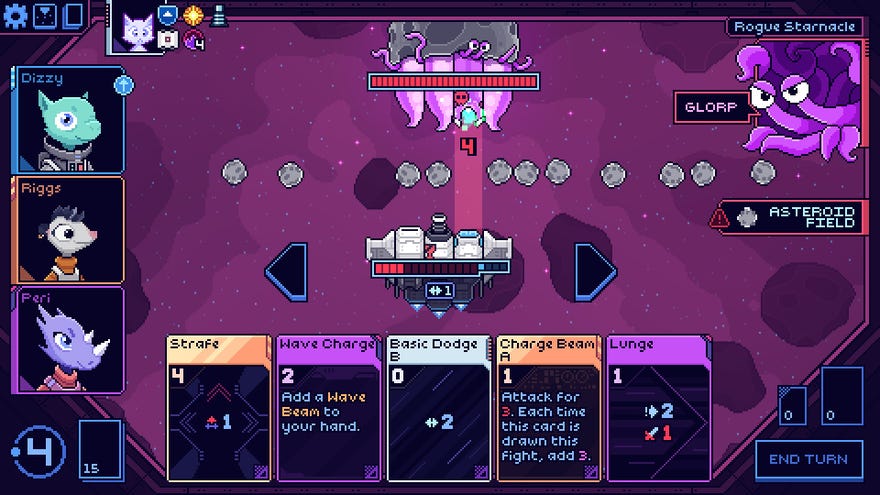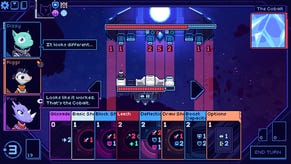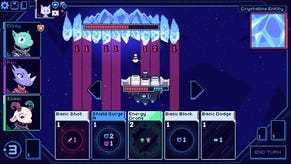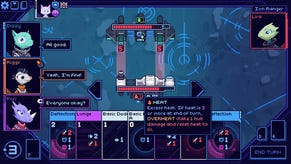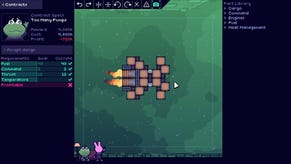Cobalt Core is wonderful because it's actually Pong
That's a paddling
I seem to be on a highly irritating "refuse to play games as they were intended to be played" spree lately. A couple of weeks ago, it was "I refuse to leave the prologue area in Skull And Bones", a decision that has sadly been born out by Ed's review. Then it was "I refuse to play Helldivers 2 as a co-op shooter", which again, is a stance I am sticking with, even as I am overrun and sat on by Terminid Chargers. And now it's "I refuse to play Cobalt Core as a roguelike deck-builder, because it secretly isn't one". Come now, squint at the header image so that the text and numbers fade away, and all you can see are coloured shapes. Pay attention to certain underlying rhythms while playing. Need I say any more?
Fine, I guess I'll show my working. To the uneducated eye, Cobalt Core might appear to be a lush tactics experience with unspeakably suave music in which kitbashed, wide-bottomed spaceships take turns to dodge, shoot or defend using the medium of cards. As in other roguelike deckbuilders, each run sees you acquiring and upgrading these cards, which correspond to ship systems such as beam cannons and shield generators, while moving through a campaign made up of minor or major enemy encounters, resourcing or repairing opportunities, and chapter-ending bossfights.
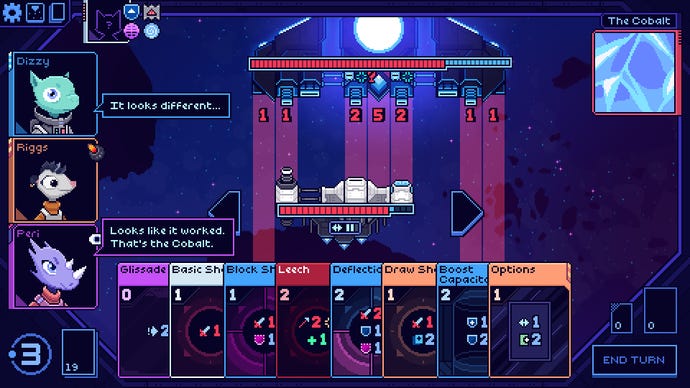
In the abstract, it might sound interchangeable with other, ultra-replayable sci-fi card-wranglers such as Breachway, another space sim I've been rogueliking lately (Steam demo here). But Cobalt Core has an arcade flourish that helps it stand apart: your ship, the enemy's ship and all projectiles rest on a layout of 2D columns. Play cards that grant you evasion tokens, and you can skip a few columns left or right to avoid telegraphed attacks (or at least, the bulk of them), ideally while lining up your own cannon with vulnerable parts of the other ship, be it a fragile hull component or a big gun you can paralyse for a turn.
It introduces a joyful element of actual dogfighting to a game that could have "just" been about card attack or defence stats, buffs or debuffs, combos or multipliers and remembering what you have in your deck. The more cards you find or spruce up, the dogfightier it gets, though there's the option to run a tank build by focussing on cards that raise your shields.
Some cards combine moving with attacking and energising your all-important shield reservoir - a feint card, for example, which launches you a couple of columns to the left, fires off a shot, then skips you back one column right. Whether moves like these are match-winners depends heavily on your choice of vessel. If you have a cannon mounted on your ship's right half, that particular feint card might not be so helpful, but if you meet certain characters on a run, you can modify or scramble your ship design to support your deck. I haven't unearthed all the ship-modifying possibilities yet, but it feels like there's some fun complexity here: you can build gaps into your ship, for example, so that attacks pass straight through.
It was while beholding the scrambled slab of my spaceship during my second run that certain aspects of the presentation and mechanics alchemised behind my eyes, and I came to a Sudden Realisation. Of course: this isn't a spaceship. It's a paddle. I am customising a paddle. And by extension, Cobalt Core is not a roguelike deckbuilder. It is, in fact, one of many, very creatively concealed homages to Breakout and Pong.
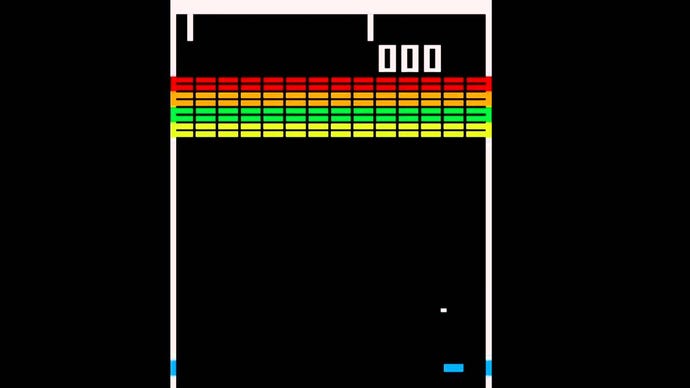
If you have never played Breakout or Pong, I can only assume that you are very young, and I hope you will forgive a foolish old man for taking you on a quick tour of memory lane (mind where the dog's been). Pong is one of the first videogames ever released, and is basically multiplayer 2D tennis with floating paddles, no net and no air friction. Breakout is a little more recent: it's Pong, but instead of trying to sneak the ball past an opponent, you're bouncing the ball off a big wall of coloured, destructible bricks, trying to clear them all away before you run out of Continues.
In both games, there's an art to not just intercepting the ball but having it touch the right point on your paddle, so as to send it zipping back at a preferred angle. In Pong, you're trying to drive an opponent to one side during a rally, before vengefully launching the ball back in the opposite direction. In Breakout, you're trying to ricochet the ball behind the bricks so that it'll bounce off the backwall and erode the whole mass from the rear, like a Honey Badger smuggled into an outpost in Far Cry 5.
Cobalt Core isn't played in real-time and isn't any kind of direct variation on tennis. Not to instantly negate the previous 800 words, but there's no ball. Still, it often seems to me that it wants to feel like Pong or Breakout, in that there's a similar focus on projectiles hitting the desired place on either your or the enemy ship. The feint move described above also makes me think of attempting to apply spin to the ball by swooshing the paddle across the screen. I don't think this is actually possible in the original Pong, but later variations or derivatives of Pong have, as it were, put their own spin on things, with mildly fancier physics.
The ability to modify your ship layout in Cobalt Core also make me think of paddle power-ups or modifiers in Breakout and its many, many successors - making the paddle wider or narrower, for example. The game's more arcane cards, including corrosive ammo and a chargeable cannon whose power increases every time it's played, also put me in mind of the wider "block buster" genre's various ball power-ups - exploding balls, balls that split in two, balls that set bricks alight, and so on.
Perhaps there is a ball in Cobalt Core. It's just that rather than being tangible, the ball has been sublimated and multiplied into a set of RPG-style energy transactions between player and enemy. I'm not sure it's a huge aspect of the game, but there are cards in Cobalt Core that let you turn the other ship's strength against them or move them around (I'm thinking, admittedly, of a particular enemy self-buff here which you can exploit), much as you'd try to throw off the other player in Pong by making confident use of its simple physics.
If nothing else, it's wonderful to catch the scent of these classics in Cobalt Core because it helps me resolve and appreciate a game that risks being perceived as a mass of genre tags. That's not Cobalt Core's fault: there are just an awful lot of competing fantasy deck-building roguelikes 'with a twist' on the shop, and I must confess that I tire myself out trying to explain the key differences to friends. With Cobalt Core, at least, I can just say "It's the one that's actually Pong". And then - as they gaze at me with deepening disgust and horror, as nearby chairs scrape back and we are surrounded by a muttering crowd of people armed with bicycle chains and broken bottles - I will triumphantly add: "And Elden Ring is better played as a walking sim."
